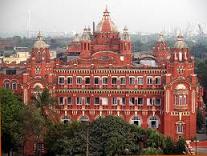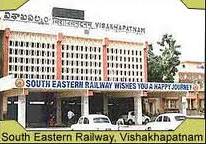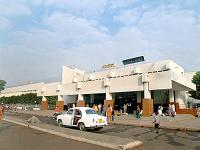 South Eastern Railway, established on 1.8.1955, is known as the Blue Chip Railway, and aptly so as it carries 40% of the originating freight traffic of the entire Indian Railways,with only 12% of the track kilometres.
South Eastern Railway, established on 1.8.1955, is known as the Blue Chip Railway, and aptly so as it carries 40% of the originating freight traffic of the entire Indian Railways,with only 12% of the track kilometres.
Traversing through the States of West Bengal, Bihar, Madhya Pradesh, Maharashtra, Orissa and Andhra Pradesh, it generates the highest surplus amongst all zones of Indian Railways. During 1998-99, while earning Rs.53.67 billion and with expenditure of Rs 34.78 billion, the railway generated a surplus of Rs 18.88 billion. Almost 90% of the earnings were from freight traffic.
The story of Bengal Nagpur Railway (BNR) now South Eastern Railway
(SER) encapsulates a classic saga the saga of growth and development in myriad ways a saga of uninterrupted continuity from the late 19th century till today. Though a late entrant, compared to the more illustrious leaders in the field, like the Great Indian Peninsular and East Indian Railway, BNR covered lost ground rapidly and emerged as a major railway system in British India by the turn of the 20th century. It is indeed ironical that embryo of this railway’s genesis did not lie in Lord Dalhousie?s scheme of things when he envisaged a system of trunk lines to connect each presidency with its principal ports and the presidencies with each other in the mid 19th century. Its fledgling inception dates back to 1882 when a 149-mile stretch of rail link was constructed in an obscure corner of Central India to combat famine. BNR took birth in 1887 to take over this scraggy line and convert it to broad gauge. What followed is history. Its founder members barely surmised its branching into so many dimensions and scaling so many new heights in such a short span of time. Today as the successor of BNR, SER has emerged as the largest freight carrier straddling across seven mineral rich states of the Indian union. Its present contribution to the freight traffic of Indian Railways is a whopping 40%. Be it its geographic spread or the traffic mix drawn around the major core streams like coal, iron and steel, fertilizers, cement etc., SER?s contribution to the Indian economy and industrial growth is unparalleled. Its role in promoting export can hardly be over emphasized serving as it does three major ports in the East Coast. It also held the unique privilege of managing the ports in their formative years.
 S. E. Railway has a distinctive identity of its own among the comity of zonal railways. It ministers to all the major power houses spread across the length and breadth of the country and maintaining the supply chain of coal to steel and other core industries. The sobriquet that SER stands for Steel Enterprise Railway is indeed very apt. Its symbiotic relationship with the iron and steel industries dates back to 1908 when the rail line connecting the first integrated steel plant in India at Jamshedpur was established. Today, S.E. Railway enjoys the unique distinction of carrying 90% of steel traffic. It has been a remarkably healthy and resilient system that has withstood waves of recession and many other vicissitudes in its life and is evenly poised today to overhaul the freight-loading target of 175.5 million tonnes set for the current fiscal. In the process, it has not only evolved strategies for creating additional infrastructure to cope with the burgeoning traffic but also evolved innovative management and maintenance practices for optimal usage of its assets. In the emerging competitive milieu, SER is now geared to function as a complete logistics provider rather than a mere transporter.
S. E. Railway has a distinctive identity of its own among the comity of zonal railways. It ministers to all the major power houses spread across the length and breadth of the country and maintaining the supply chain of coal to steel and other core industries. The sobriquet that SER stands for Steel Enterprise Railway is indeed very apt. Its symbiotic relationship with the iron and steel industries dates back to 1908 when the rail line connecting the first integrated steel plant in India at Jamshedpur was established. Today, S.E. Railway enjoys the unique distinction of carrying 90% of steel traffic. It has been a remarkably healthy and resilient system that has withstood waves of recession and many other vicissitudes in its life and is evenly poised today to overhaul the freight-loading target of 175.5 million tonnes set for the current fiscal. In the process, it has not only evolved strategies for creating additional infrastructure to cope with the burgeoning traffic but also evolved innovative management and maintenance practices for optimal usage of its assets. In the emerging competitive milieu, SER is now geared to function as a complete logistics provider rather than a mere transporter.
Some Facts
The South Eastern Railway passes through eight States of the Union of India. The Railway is divided into eight divisions viz. Adra and Kharagpur in West Bengal, Sambalpur and Khurda Road in Orissa, Visakhapatnam in Andhra Pradesh, Chakradharpur in Jharkhand, Bilaspur in Chhattisgarh, and Nagpur in Maharashtra. The new divisions namely Ranchi in Jharkhand and Raipur in Chhattisgarh have been announced and are in the offing.
The South Eastern Railway accounts for only 12% of total length of rail-lines of Indian Railways, but it carries over 39% of the total goods traffic on all the railway zones together. The areas served by SER are principally rich in basic minerals such as coal, iron ore, manganese ore, limestone, dolomite, bauxite etc.
 The raw material requirements of seven major steel plants of the country viz., the Tata Iron and Steel Works at Jamshedpur, the Indian Iron and Steel Works at Burnpur; Rourkela, Bhilai and Durgapur Steel Works of Steel Authority of India; Bokaro Steel Works and the new Visakhapatnam Steel Works, have to be largely, if not solely, catered to by this Railway. Of the seven plants, five are located on the South Eastern while both SER and Eastern Railway serve the Burnpur Works and a substantial portion of material for Durgapur Works is hauled by SER. The entire steel economy of the nation is geared to this Railway, which has therefore been aptly called as the Steel Railway of India.
The raw material requirements of seven major steel plants of the country viz., the Tata Iron and Steel Works at Jamshedpur, the Indian Iron and Steel Works at Burnpur; Rourkela, Bhilai and Durgapur Steel Works of Steel Authority of India; Bokaro Steel Works and the new Visakhapatnam Steel Works, have to be largely, if not solely, catered to by this Railway. Of the seven plants, five are located on the South Eastern while both SER and Eastern Railway serve the Burnpur Works and a substantial portion of material for Durgapur Works is hauled by SER. The entire steel economy of the nation is geared to this Railway, which has therefore been aptly called as the Steel Railway of India.
The South Eastern Railway also serves three major coalfields namely, the Bengal and Bihar coalfields, the Central India coalfields and the Talcher coalfields. It also serves a portion of the Pench Valley coalfields with its narrow gauge Satpura lines in Nagpur Division.
Two major integrated aluminium complexes viz., Bharat Aluminium Company’s works at Korba and the new plant of National Aluminium Company at Machiliguda in Orissa are wholly served by S.E. Railway. Four major ports namely, Calcutta, Visakhapatnam, Haldia and Paradeep and a number of small ports are served by South Eastern Railway. Visakhapatnam port plays an important role in large-scale export of iron ore mined in Bailadilla and brought by the Kottavalasa-Kirandul line of South Eastern Railway.
At the turn of the new millennium, in 2000-1, South Eastern Railway is well poised for a originating loading target of 175.5 million tones all revenue earning.
The South Eastern Railway (SER) is headquartered at Garden Reach, Kolkata. It comprises four divisions:
1. Adra Railway Division
2. Chakradharpur Railway Division
3. Kharagpur Railway Division
4. Ranchi Railway Division
MORE ABOUT US
click above to know more
about South Eastern Railway
Sponsored Links
